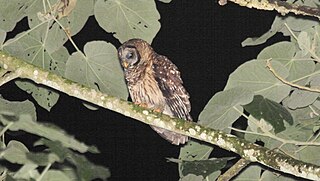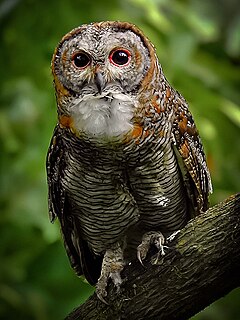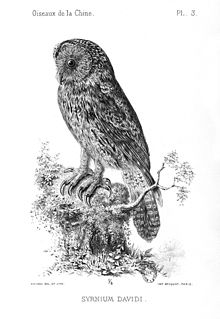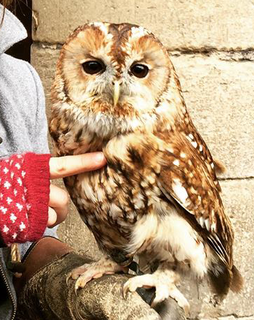 W
WStrix is a genus of owls in the typical owl family (Strigidae), one of the two generally accepted living families of owls, with the other being the barn-owl (Tytonidae). Common names are earless owls or wood owls, though they are not the only owls without ear tufts, and "wood owl" is also used as a more generic name for forest-dwelling owls. Neotropical birds in the genus Ciccaba are sometimes included in Strix.
 W
WThe African wood owl or Woodford's owl, is a typical owl from the genus Strix in the family Strigidae which is widespread in sub-Saharan Africa.
 W
WThe barred owl, also known as the northern barred owl, striped owl or, more informally, hoot owl, is a North American large species of owl. A member of the true owl family, Strigidae, they belong to the genus Strix, which is also the origin of the family's name under Linnaean taxonomy. Barred owls are largely native to eastern North America, but have expanded their range to the west coast of North America where they are considered invasive. Mature forests are their preferred habitat, but they can also acclimate to various gradients of open woodlands. Their diet consists mainly of small mammals, but this species is an opportunistic predator and is known to prey upon other small vertebrates such as birds, reptiles, and amphibians, as well as a variety of invertebrates.
 W
WThe black-and-white owl is a species of owl in the family Strigidae.
 W
WThe black-banded owl is a species of owl in the family Strigidae. Entirely nocturnal, this midsized black and white neotropical bird is a resident species, therefore never migrates out of its native South America. Its natural habitats are varied subtropical or tropical forests ranging from lowlands to areas of medium altitude, and it has been found in Argentina, Bolivia, Brazil, Colombia, Ecuador, French Guiana, Guyana, Paraguay, Peru, Suriname, and Venezuela.
 W
WTawny owls are monogamous and territorial year around. Young birds select territories and look for mates in autumn and tend to be very vocal, especially males. Due to their highly territorial behaviour, young birds frequently struggle to establish a territory unless a nearby adult dies. Males routinely engage in territorial fights. Territories have been known to have been maintained by single tawnys for up to 10 years in Russia and 13 years in Berlin. Of 34 males in Wytham, only one male moved off of territory, due to being disturbed by humans. It appears to be largely up to the male to select territorial boundaries. Despite the aforementioned territorial behaviour, active nests of two separate pairs at as close as 100 m (330 ft), in the Tegel forest, have been reported. This species shows very little extrapair parentage. In Switzerland for example, a study of 137 nestings found that only one, or 0.7%, were from a different father than the mate, females cannot generally raise young without male contribution so the pair structure of these highly residential owls insures little instance of cuckoldry. Cases of bigamy were reported at Wytham in 6 of 34 males, in situations where apparently a neighboring male died and was suffixed subsequently, however, one or the other nesting attempts would completely fail each time. In Pavia, 3 of 22 territories included two mature females.
 W
WThe brown wood owl is found in India, Bangladesh, Sri Lanka, Indonesia, Taiwan, and south China. The brown wood owl is a resident breeder in south Asia. This species is a part of the family of owls known as typical owls (Strigidae), which contains most species of owl. It belongs to the earless owl genus Strix.
 W
WThe Chaco owl is an owl found in Argentina, Bolivia, and Paraguay.
 W
WThe desert owl or desert tawny owl, formerly known as Hume's owl, is a species of owl. It is closely related to the more widespread tawny owl and to the range-restricted Omani owl.
 W
WThe tawny owl is an opportunistic and generalized predator. Peak hunting activity tends to occur largely between dusk to midnight, with owls often following an erratic hunting pattern, perhaps to sites where previous hunts were successful. When feeding young, hunting may need to be prolonged into daylight in the early morning. Based on hand-reared young owls that re-released into the wild, hunting behaviour is quite innate rather than learned. Normally this owl hunts from a perch. Perching bouts usually last from about 8 to 14 minutes depending largely on habitat. Tawny owl's hunting from a perch or pole can recall a buzzard and the two take similar prey sizes as well. However, high initial speed and maneuvering among trees and bushes with great dexterity may allow it to surprise relatively large prey, more like a goshawk. The tawny owl is capable of lifting and carrying off in flight individual prey weighing up to at least 320 g (11 oz). Their middle talon, the most enlarged claw on owls, measures an average of 19.1 mm (0.75 in). While not as large as those of the Ural owl, the talons are extremely sharp, stout and quite decurved. The claws are considered to be visibly more overdeveloped than those of other European mid-sized owls and the footspan including the claws is fairly larger as well, at an average of about 13.4 cm (5.3 in). The hunting owl often extends its wings to balance and control prey upon impact. Alternatively, this species may hunt from flight. This occurs from 2 to 3 m over the ground, often over open habitats such as bushes, marsh or grassland, forming a quartering or zigzag pattern over the opening. During these flights they cover about 30 to 50 m before changing direction. Hunting from flight was surprisingly prevalent in a Swedish study of two radio-tagged birds, with 34% of study time spent hunting from flight while 40% of the study time was spent on hunting from a perch. In a similar study in England, less than 1% of time was spent hunting from flight. In a more deliberate variation of hunting from flight, the hunting owl may examine crags and nest boxes or also hover around prey roosts. In the latter type of hunts, the tawny owls may strike branches and/or beat their wings together in front of denser foliage, bushes or conifers in order to disturb and flush prey such as small birds and bats, or may dive directly into said foliage. Hovering has also been recorded in differing circumstances, including one incidence of an owl hunting a small bird that was caught on the wing after a hovering flight. Tawny owls have also taken bats on the wing as well and have been seen to hawk large, relatively slow-flying insects such as some beetles and moths in flight. Caterpillars may too be taken from trees. Usually these hunting variations are correlated with poor weather hampering the capture of preferred prey. Tawny owls eat worms with relative frequency, as they often hear them apparently from below the surface and snatch them up from shallow dirt or below leaf litter. Their worm-hunting style recalls worm hunting techniques by most other birds and they were recorded to eat 0.39 worms per minute during an hour of observation in England and were sometimes seen to feed on worms during daylight. Other hunting from the ground has been observed, often of insects such as beetles, but tawny owls have also been reported to "leap" upon from a ground vantage point in order to capture a vole, quite like foxes often do. There are now many accounts of tawny owls feeding on carrion from a wide range of sources, including hares, rats, sheep, and trout.
 W
WThe fulvous owl, or Guatemala barred owl, is a resident of the cloud forests of Central America. A medium-sized true owl, it has a round head, lacking ear tufts. Typical coloration is warm dark brown or reddish brown on the back and lighter brown on the front with darker barring. Adults weigh approximately 600 grams (21 oz), with females being heavier. Its distribution is limited to highland regions of Guatemala, Honduras, and El Salvador. It inhabits elevations from 1,200 to 3,100 meters, and is fairly common within its range. Its behavior is poorly known, as are its population size and distribution. It is classified as a species of least concern by the International Union for Conservation of Nature, although it is considered endangered in Mexico.
 W
WThe great grey owl or great gray owl is a very large owl, documented as the world's largest species of owl by length. It is distributed across the Northern Hemisphere, and it is the only species in the genus Strix found in both Eastern and Western Hemispheres. In some areas it is also called Phantom of the North, cinereous owl, spectral owl, Lapland owl, spruce owl, bearded owl, and sooty owl.
 W
WThe Himalayan owl, also known as the Himalayan wood owl, is an owl of the forests of the Asia, from the Himalayas to Korea and Taiwan. It is sometimes considered a subspecies of the tawny owl, but is separated from that species due to its distinctive call, darker plumage and shorter, barred tail.
 W
WThe Maghreb owl is an owl of the earless owl genus, Strix. It occurs in northwestern Africa from Morocco to Tunisia and Mauritania. It was previously considered a subspecies of the tawny owl.
 W
WThe mottled owl is a medium-sized owl found in Central and South America from Mexico to Brazil and Argentina. The head and back are mottled brown and the underparts whitish, with vertical bars on the chest and throat. The eyes are dark and the head is round and they do not have ear tufts. They are territorial and found in dry forests and jungles at altitudes of up to 2,500 m (8,200 ft) above sea level.
 W
WThe mottled wood owl is a species of large owl found in India. They are found in gardens and thin deciduous forests adjacent to dry thorn forests or farmland. They are easily detected by their distinctive tremulous eerie calls at dawn and dusk. The characteristic call is a duet of the male and female while other notes include a low hoot and a screech. Their large size, lack of "ear" tufts and the concentric barring on the face make them easy to identify.
 W
WThe northern spotted owl is one of three spotted owl subspecies. A western North American bird in the family Strigidae, genus Strix, it is a medium-sized dark brown owl native to the Pacific Northwest. An important indicator species, the northern spotted owl remains threatened due to continued population decline from human-caused habitat destruction and competition with invasive species, its main competitor being the barred owl.
 W
WPère David's owl is an owl found in the mountains of central China. There is debate over whether it is a separate species or an isolated subspecies of Ural owl. The Clements Checklist of Birds of the World considers it separate, but BirdLife International and IUCN treat it as a subspecies.
 W
WThe rufous-banded owl is a species of owl in the family Strigidae. It is found in Bolivia, Colombia, Ecuador, Peru, and Venezuela.
 W
WThe rufous-legged owl is a medium-sized owl. It is found in Argentina and Chile.
 W
WThe rusty-barred owl is a species of owl distributed mainly in the south of Brazil and further inland to Paraguay and the extreme northeast of Argentina. The rusty-barred owl is one of only a few members of the genus Strix to be found in South America. It is elusive and probably quite rare, and as a result has been little studied. The classification in Strix is therefore probably only temporary, until more information can be gathered on the nature of the owl.
 W
WThe spotted owl is a species of true owl. It is a resident species of old-growth forests in western North America, where it nests in tree hollows, old bird of prey nests, or rock crevices. Nests can be between 12 and 60 metres high and usually contain two eggs. It is a nocturnal owl which feeds on small mammals and birds. Three subspecies are recognized, ranging in distribution from British Columbia to Mexico. The spotted owl is under pressure from habitat destruction throughout its range, and is currently classified as a near-threatened species.
 W
WThe spotted wood owl is an owl of the earless owl genus, Strix. Its range is disjunct; it occurs in many regions surrounding Borneo, but not on that island itself.
 W
WThe tawny owl is commonly found in woodlands across much of Eurasia and North Africa, and has 11 recognized subspecies. It is a stocky, medium-sized owl, whose underparts are pale with dark streaks, and whose upper body may be either brown or grey.. The tawny owl typically makes its nest in a tree hole where it can protect its eggs and young against potential predators. It is non-migratory and highly territorial: as a result, when young birds grow up and leave the parental nest, if they cannot find a vacant territory to claim as their own, they will often starve.
 W
WThe species was first described by Linnaeus in his Systema naturae in 1758 under its current scientific name. The binomial derives from Greek strix "owl" and Italian allocco, "tawny owl". Some early descriptions upon review were found to have somehow conflated the very different barn owl with the scientific name Strix aluco, which in turn engendered some confusion.
 W
WThe Ural owl is a large nocturnal owl. It is a member of the true owl family, Strigidae. The Ural owl is a member of the genus Strix, that is also the origin of the family’s name under Linnaean taxonomy. Both its common name and scientific name refer to the Ural Mountains of Russia where the type specimen was collected. However, this species has an extremely broad distribution that extends as far west as much of Scandinavia, montane eastern Europe, and, sporadically, central Europe, thence sweeping across the Palearctic broadly through Russia to as far east as Sakhalin and throughout Japan. The Ural owl may include up to 15 subspecies, but most likely the number may be slightly fewer if accounting for clinal variations.